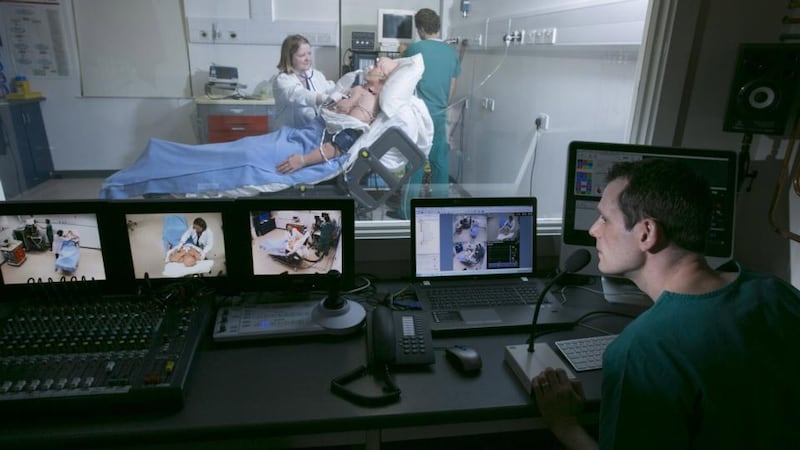Two young doctors are treating a 60-year-old man who was brought into a hospital emergency department complaining of severe pain in his left shoulder, and shortness of breath. They check his blood pressure, set up an electrocardiograph (ECG) to record the electrical activity of his heart, and take bloods.
One doctor orders aspirin and morphine for the patient while the other questions the man about the location and intensity of the pain, his breathing and any other symptoms. The patient is on oxygen and has been connected to a variety of monitors that the doctors are watching.
He informs them that he was going for his morning walk when he suddenly started to feel very unwell and began to sweat before the pain came on. His father had heart surgery in his early 70s after a bad heart attack and his sister is on blood pressure medication, he says.


The young doctors glance at each other and remain calm as the man’s breathing becomes more laboured and he complains of worsening pain. One informs the patient that he may be having a heart attack and they need to get him down to the Cath lab, an examination room with diagnostic equipment that can check the arteries and chambers of his heart for blockages or other abnormalities. In the meantime, the second doctor has phoned the cardiology registrar to explain that they are sending down a patient with a suspected heart attack.
It's a typical scenario for a doctor in an emergency department to be presented with but in this situation, the patient in the bed is not human, but a very realistic mannequin (costing €250,000) and the doctors are fifth-year medical interns at University College Cork. They are training in a high fidelity (which basically means highly realistic) suite at the new Assert for Health Centre at UCC's School of Medicine.
The trainees had no idea what type of medical situation they were going into when they entered the suite and their every word and action is being captured on camera. From a control booth, Assert manager Dave Power and the course tutors replicate events that can happen in real medical settings. The sensorised patient describes his symptoms in a real voice (coming via a microphone in the control booth) and his pulse and even the diameter of his eyes can be controlled from the booth. The “patient” responds to various efforts made by the training team to solve whatever problem they are confronted with, and the scenario can be controlled to pose additional challenges.
A small group of the trainees’ fellow interns watch through a one-way window, and immediately after each training session, their tutor sits down with them to debrief their performance using their video and audio data.
Although simulation in medical training is now commonplace, Prof Tony Gallagher and the Assert team have developed techniques to measure precisely how well each person performs and to train them to an acceptable and measurable standard. They address the key questions “How good am I ?” and “How good is good enough?”
It’s the future of global medicine and the Cork-based centre is at the forefront of international advances in this area. The Assert for Health project was established three years ago at UCC’s Brookfield Health Sciences campus and will move into a 2,400 sq m state-of-the-art facility on the site this autumn.
The new centre will provide internal and external high-fidelity simulation suites including operating theatres, a mock ward with role players and full-physics virtual reality simulation for high-risk procedures, as well as elearning laboratories and a multifunctional laboratory suitable for cadaveric training.
Dave Power, the manager of Assert, explains that simulation provides a safe environment for health professionals (students, trainees and practitioners) to develop and maintain their skills, either alone or as members of teams.
“Trainee doctors do still practise on patients but it is becoming no longer acceptable. The old practice of ‘see one, do one, teach one’ is changing. In a simulated environment, people can practise their skills until they get it right so that when they are under pressure in a real-life scenario they will be able to do it right,” he says.
Part of the simulation suite is a mock ward where patients, played by actors, lie in hospital beds. While it is harder for the trainees to practise procedures on these role players (they can’t stick needles into them, for example), they can practise their diagnostic skills and bedside manner. They also get to experience a wide variety of the type of patient they are likely to come across in real life, including drunken, confused and difficult patients and their relatives.
One room in the centre is full of mannequin arms where students practise injecting, inserting lines, drawing blood and stitching. There are even fake bottoms that twitch when stuck with a needle.
With many countries now investing heavily in simulation-based healthcare training programmes, the Assert team have gone one step further by developing a highly effective methods for this form of training.
Prof George Shorten, the director of Assert and former dean of the school of medicine at UCC says: “The college of medicine and health at UCC developed Assert to address the global challenge of ensuring that health professionals can and do deliver better, safer healthcare for their patients. The need for a new, rigorous and evidence-based approach to medical training has been identified by governments, health services and training bodies around the world.”
One of the primary drivers for the establishment of Assert, according to Shorten, was the patient safety agenda and the worldwide incidence of death and injury due to medical error. Other drivers were the decrease in clinical learning opportunities available to specialist trainees across the developing world with the introduction of the European Working Time Directive; legislative changes within countries such as the Medical Practitioners Act 2007 in Ireland and regulatory changes in the licensing of new technologies and devices.
He says: “The Assert approach to decreasing medical error enables trainees to engage in the deliberate practice of clinical skills to predefined proficiency standards in the safe environment of its technology-enhanced learning centre.
“We are confident that Assert will be a global leader in technology-enhanced learning for health professionals. The facilities we will offer will be amongst the best anywhere. However, what separates Assert from other centres is the application of a scientifically rigorous methodology to human performance in healthcare.”
It’s not just doctors who are availing of the centre, but a wide range of healthcare professionals including undergraduate students, trainees and independent practitioners across all the disciplines – medicine, nursing, pharmacy, dentistry, speech and language and occupational therapies – as well as the allied health professions, the military, the Garda, pre-hospital care teams and others.
Shorten believes proficiency-based progression should become a norm for the training of health professionals. He says it has already shown marked superiority when compared like for like with the best existing training programmes both in the simulated and clinical environment.
Case study
Niamh Mullane, final med student at University College Cork
When I went along to a recent emergency simulation training day at the Assert Centre for Health, I was a little apprehensive about what lay ahead as I had no idea what kind of a scenario I was walking into.
My patient was a lifelike mannequin who made breathing sounds and showed all the vital signs. A nurse gave me a brief rundown of the patient’s symptoms before I spoke to him. It was quite a pressurised situation because it was all being videoed and I was aware that a group of my classmates were watching my every move from behind a glass screen.
It was very realistic. I had to write out prescriptions for medication to give to the nurse and sign off on treatment, just like on a real hospital ward.
The patient complained of shortness of breath and it looked like he was having an asthma attack initially but then he went into full cardiac arrest and I had to start CPR and call for a crash team. The vitals on the monitors were changing as I was treating him so I knew very quickly whether I was doing something right or wrong.
Two of my tutors watched the simulation and when we reviewed the footage straight afterwards, they highlighted the areas where I did particularly well and those where I could improve.
On clinical placement throughout the year, you are attached to a doctor in the hospital and you get to observe a lot, but this was the first time I got to practise a real-life emergency scenario. It’s a rare opportunity to be given so much responsibility and just as in a real-life situation, you have to make decisions very quickly.



















